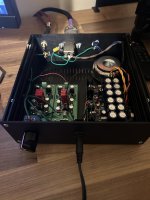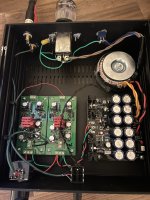I bought some headphone amp boards from a local electronic store with quality parts and a really good design, but I could use some help figuring out how to increase the gain for some more output. I currently use two pairs of headphones that are 250 and 300 ohm and I find myself having to turn the volume up 3/4 of the way for normal listening levels where my Whammy I can't even get to halfway.
The headphone amp boards were supposed to come with four LME49710 but two were missing. I am instead using Burson Vivid opamps (V5 pair & V6 pair) now in all four positions. I am using a VRDN set at +-15 Volts.
I am wondering if I NEED to use LME 49710 in all 4 locations (or maybe just in the inverting circuit) to get the unit to perform correctly or if I can change a couple resistors to increase the gain without changing the distortion. The part of the circuit I believe I need to focus on is this one. Could I safely change R10 to 6.8k ohms to result in a gain of 10 where previously it was 5.9.
Or, should I adjust the gain in Stage 2 where it is set to only a gain of 1? I have included the full documentation of the headphone boards in the attachment.
Any help is appreciated here. I really like this circuit but could appreciate it more if it had some more UMPH!


The headphone amp boards were supposed to come with four LME49710 but two were missing. I am instead using Burson Vivid opamps (V5 pair & V6 pair) now in all four positions. I am using a VRDN set at +-15 Volts.
I am wondering if I NEED to use LME 49710 in all 4 locations (or maybe just in the inverting circuit) to get the unit to perform correctly or if I can change a couple resistors to increase the gain without changing the distortion. The part of the circuit I believe I need to focus on is this one. Could I safely change R10 to 6.8k ohms to result in a gain of 10 where previously it was 5.9.
Or, should I adjust the gain in Stage 2 where it is set to only a gain of 1? I have included the full documentation of the headphone boards in the attachment.
Any help is appreciated here. I really like this circuit but could appreciate it more if it had some more UMPH!
Attachments
You can just increase the first stage gain as you mentioned, up to the point where it could be overloaded.
What is driving the first stage, and can it handle the 680R load? Many sources could not.
What is driving the first stage, and can it handle the 680R load? Many sources could not.
Last night when I was listening to it I was using a Schiit Gungir with 2V output and 75 ohm impedance.
The 75R output impedance of the source does not necessarily imply an ability to properly drive
any particular load. In this case, there is no specific minimum load listed, so you just don't know.
Also, if there is an output capacitor, the bass could be cut off by the low 680R load.
Nevertheless, I would try 10k and 100k for the feedback components, to see if that helps.
Or ask Schiit what is the minimum load recommended, and whether there is an output capacitor to consider.
any particular load. In this case, there is no specific minimum load listed, so you just don't know.
Also, if there is an output capacitor, the bass could be cut off by the low 680R load.
Nevertheless, I would try 10k and 100k for the feedback components, to see if that helps.
Or ask Schiit what is the minimum load recommended, and whether there is an output capacitor to consider.
Unfortunately, the guy that provided the kit no longer stocks them in the store and the store owner said he has not been able to contact him.
So, you recommend I change:
R9 to 10k
R10 to 100k
Gain of 10
So, you recommend I change:
R9 to 10k
R10 to 100k
Gain of 10
You don't need any more info about the headphone amp. Just the source.
I would give that change in feedback a try. It should fix the problems, if they are what you think they are.
I would give that change in feedback a try. It should fix the problems, if they are what you think they are.
If you decide that is necessary, keep the 10k constant, but install two series 50k for the feedback.
Wire the switch to short out the 50k connected to the output, when you need low gain.
Wire the switch to short out the 50k connected to the output, when you need low gain.
You can replace momentarily R10 with a 20 or 50K linear preset wired as rheostat (wiper to one end) and find the value of resistance you need. Once you found satisfacrory gain, you can place again a fixed resistor with the nearest available value.
Good news. I had some RN55 Dale 100k and 10k on hand and made the switch.
The resistor changes worked perfectly and the unit has more than enough gain. I may dial it down later but it makes the unit perform with as much gain as my Whammy.
Thank you for your help here.
The resistor changes worked perfectly and the unit has more than enough gain. I may dial it down later but it makes the unit perform with as much gain as my Whammy.
Thank you for your help here.
Attachments
10k/100k is perhaps too high - risk of increasing the noise floor. Anything with opamp outputs can usually drive 2k happily, so 2k2/22k perhaps?
But this is an inverting amp and is reversing the phase - a non-inverting topology is possibly a better choice, and doesn't interact with the source output impedance as much.
But this is an inverting amp and is reversing the phase - a non-inverting topology is possibly a better choice, and doesn't interact with the source output impedance as much.
- Home
- Amplifiers
- Headphone Systems
- Help with increasing gain in headphone circuit

